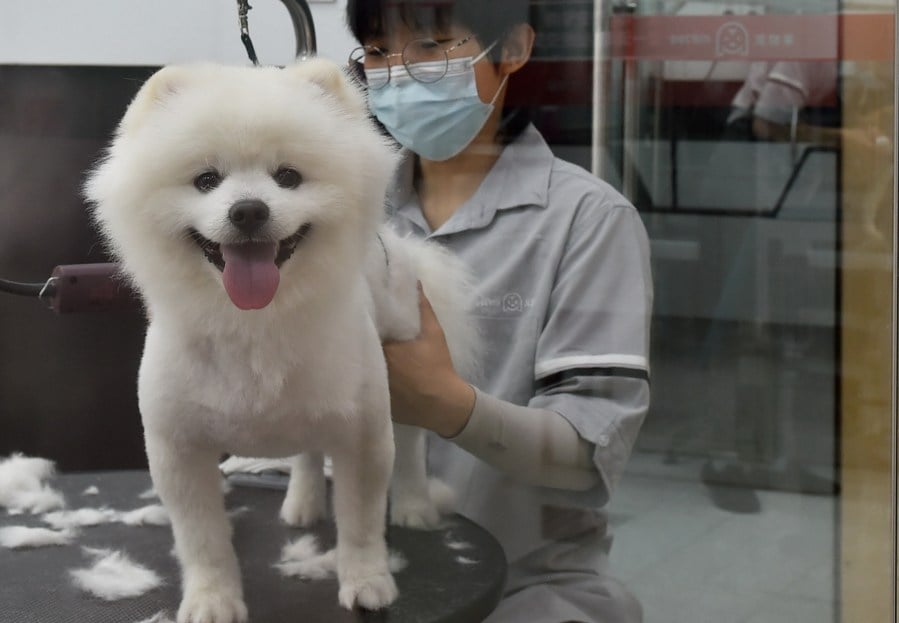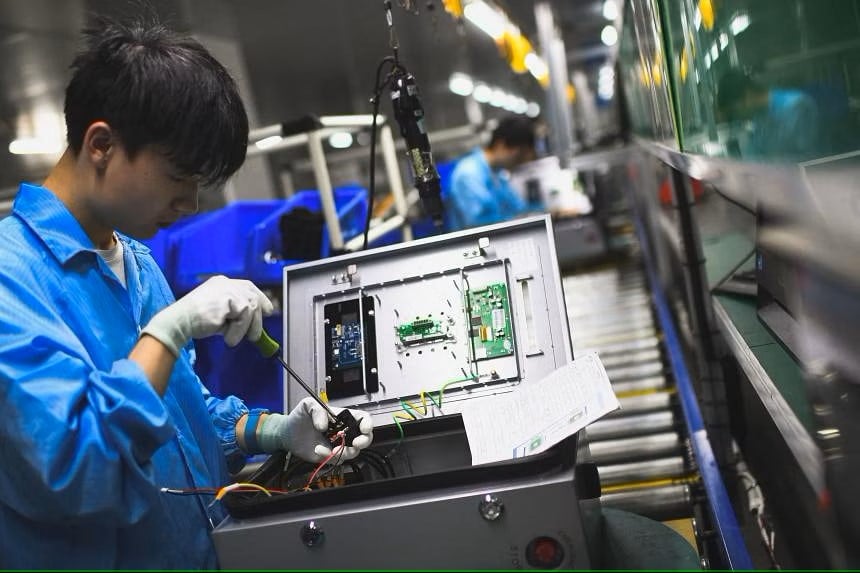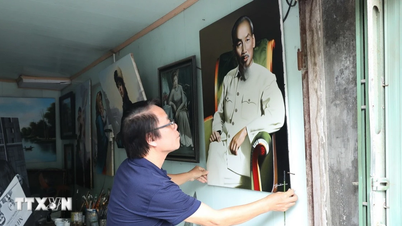Choose manual labor over mental labor
In an interview with Lianhe Zaobao, the 28-year-old said she saw no clear path to advancement in her previous administrative job and could even be laid off after turning 30. But learning a craft gave her the greatest sense of security. “I can survive even if I open a street stall,” Liu said.

A job as a pet groomer in China can bring in an income of 1,400 USD/month. Photo: Xinhua
After nearly two years as a pet groomer, Liu’s monthly income has increased from 3,500 yuan ($490) to about 10,000 yuan ($1,400). She is not currently considering a career plan and prefers to “live day by day.”
Over the past year, more and more Chinese college graduates like Liu have been casting aside their reservations to take on light manual jobs. Unlike traditional manual work, which requires physical strength, light manual work is mostly done indoors and includes jobs such as baristas, convenience store clerks, bookstore clerks, cashiers and appliance installers.

Traditionally undervalued compared to academic disciplines, vocational training has received more attention in recent years as China's economy needs a large number of skilled workers and technicians. Photo: Straits Times
On Chinese social media platform Douban, a hobby group for light manual labor founded in 2022 has seen its membership multiply over the past year, exceeding 88,000.
In June, Chinese job platform Zhaopin released its annual report on blue-collar talent development, showing that in the first quarter of 2024, blue-collar job applications among job seekers under the age of 25 increased by 165% year-on-year.
The "devaluation" of academic degrees
A 2013 study by the Shanghai Institute of Education found that the number of college graduates in China will increase by 94 million between 2010 and 2020. During the same period, there are only 46 million white-collar jobs available in the country, so more than half of China's college graduates will have to work in manual labor.
But now, as China's economy continues its slow recovery, the fragile domestic job market means competition for blue-collar jobs is becoming fiercer.
This year, a record 11.87 million Chinese students graduated from high school. At the same time, Chinese authorities reported that youth unemployment remains high. In June of this year, 13.2 percent of young people aged 16 to 24 who were not in school were unemployed; for those aged 25 to 29, the figure was even higher at 14.9 percent.
In an interview with Lianhe Zaobao, Deng Xize, an international relations professor at Sichuan University, said that college enrollment has increased sharply since the 1990s, increasing from 610,000 places in 1990 to 5.04 million in 2005 and 10.14 million in 2022.
However, the supply of good jobs has not kept pace, so college graduates are getting diminishing returns on their investment in education and more and more of them are turning to manual labor.

Fresh college graduates visit a local career services center to look for jobs in Fuzhou, Fujian province. Photo: China Daily
Professor Deng feels that as technological advances accelerate, especially in the field of artificial intelligence that can replace repetitive work, the job market will only become more challenging in the coming times.
“While we may feel sorry for college graduates working as food delivery or ride-hailing drivers today, the reality is that even such opportunities may become scarce in the future,” he said.
After spending a lot of effort to get a degree only to find out that the market value of one's degree is not as high as expected, the devaluation of academic degrees in China has become worse in recent years.
But Professor Deng explains that the devaluation of academic degrees is a global phenomenon, and that university graduates in developed countries have long since taken up manual labor. In fact, he feels that given the convergence of factors such as technological advances and education systems that fail to meet society’s needs, a “collapse” in the value of academic degrees is a more appropriate description than “devaluation.”
For Professor Deng, the harsh reality is that it is getting harder and harder globally to secure a stable job and a decent income. As a result, both low- and high-skilled job seekers feel desperate.
Those with lower levels of education have less incentive to invest in education, as it no longer brings a corresponding improvement in the quality of life. Conversely, those with higher levels of education see their expectations decline because their educational achievements result in lower returns than previous generations.
The trend is "progressive" and will continue to increase
Frustrated by a lack of job opportunities, Chinese college students have shifted from an obsessive belief in academic qualifications to a focus on practical skills. This shift also reflects a disconnect between China’s higher education system and the real needs of the job market.

A student works as a delivery man in Nanjing. In the first quarter of this year, the number of Chinese youth under the age of 25 applying for manual jobs increased by 165% compared to the same period in 2019. Photo: Caixin
In a commentary published in Lianhe Zaobao, Liu Hongbin, a lecturer at the School of Economics and Management, Zhejiang University of Science and Technology, and Yu Gui'e, a lecturer at the School of Accounting, Zhejiang University of Industry and Commerce, stressed that higher education institutions must obtain administrative approval to establish majors for students.
This requirement makes it difficult for universities to keep up with market demand, leading to a disconnect between the talent they train and the needs of the job market.
Looking at the numbers, the demand for manual labor is growing. Based on data from Zhaopin, the number of manual labor jobs has tripled since 2019.
According to a 2023 research report on the employment situation of manual workers in China, the monthly income of manual workers increased by 125% from 2,684 to 6,043 yuan (US$850) from 2012 to 2023; during the same period, the salary of white-collar workers increased by only 25% from 6,439 to 8,388 yuan (US$1,200).
Mr. Wei Zhizhong, chief psychological counselor at Yiweiduxin Psychological Counseling Center (Guangzhou), said that the growing preference of young Chinese people for manual work instead of focusing on joining the civil service is, to some extent, a return to reason.
Mr. Wei observed that traditional Chinese thinking often views manual labor as inferior. “Young people making a living through manual labor, managing their own lives as they see fit, and redefining success in their own way—this is progress,” he said.
Dr Yu Tao, associate professor of Chinese Studies at the University of Western Australia, also believes that the trend of new graduates taking up manual jobs in China will increase as thinking about this type of work has changed.
Nguyen Khanh
Source: https://www.congluan.vn/xu-huong-sinh-vien-trung-quoc-ngay-cang-chon-lao-dong-chan-tay-post309792.html






![[Photo] National Assembly Chairman Tran Thanh Man meets with Thai Prime Minister Paetongtarn Shinawatra](https://vphoto.vietnam.vn/thumb/1200x675/vietnam/resource/IMAGE/2025/5/15/e71160b1572a457395f2816d84a18b45)
![[Photo] Prime Minister Pham Minh Chinh receives Country Director of the World Bank Regional Office for Vietnam, Laos, Cambodia](https://vphoto.vietnam.vn/thumb/1200x675/vietnam/resource/IMAGE/2025/5/15/2c7898852fa74a67a7d39e601e287d48)


![[Photo] Explore the Great Wall of Water in the Suburbs of Beijing, China](https://vphoto.vietnam.vn/thumb/402x226/vietnam/resource/IMAGE/2025/5/5/c2e706533d824a329167c84669e581a0)
























































































Comment (0)